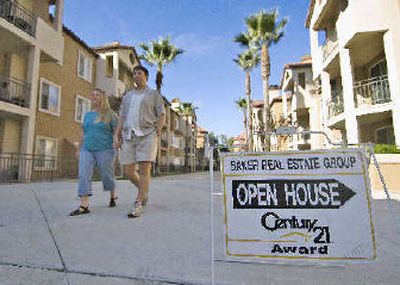For some, it’s a buyer’s market

Third in a series
SAN DIEGO — When Jason and Laura Bennett bought their home two years ago, the housing market was among the hottest in the nation. Would-be buyers made offers as soon as “For Sale” signs went up, then bid even higher in the frenzy to close the deal.
Now sellers, the Bennetts have to chase buyers.
Less than two months after the couple listed their two-bedroom, two-bath condo, they’ve had to slash the high-end of their asking price by $10,000 to keep up with other sellers in the same complex who have dialed back prices in hopes of hooking a buyer.
“It’ll be good for us when we are on the buying end, because there are a lot of motivated sellers,” said Laura Bennett, 33, a kindergarten teacher. “But on the selling end, it’s a little bit harder for us because there’s so much available right now and it’s moving so slow.”
The national housing market has begun showing signs of a slowdown, with the rate of home price increases easing this year in some areas where double-digit percentage hikes became almost routine in recent years.
Experts say the trend should continue next year, particularly if mortgage rates continue to trend upward, squeezing some buyers’ ability to afford home loans.
“You can’t sustain 20 percent plus price growth,” said Walter Molony of the National Association of Realtors, which forecasts sales next year to cool 3.5 percent. “You’re definitely going to come up to a brick wall of affordability where first-time buyers can’t afford to get into the market.”
In San Diego, one of the first housing markets in the nation to take off in the late 1990s, home appreciation began a steady cooldown this year, tipping the scales in favor of homebuyers again — a fate that would-be buyers elsewhere could soon share as prices in other markets cool.
The annual rate of home appreciation in San Diego County hit double digits in 1998 and peaked at 27.4 percent in November 2002. It bottomed out in August at 2.1 percent.
Declines into the single digits have also occurred in areas such as Boston, which also experienced brisk home price gains during the real estate boom.
“We really believe it’s a return to normalcy,” said Patrick Lashinsky, senior vice president of product strategy for ZipRealty Inc. “It could swing all the way past normal into being a buyers market; we won’t know that for a while.”
In San Diego, homes are now on the market an average of 43 days — almost twice as long as a year ago.
“We can’t seem to get anybody to make an offer,” said Robert Vaughan, whose four-bedroom, three-and-a-half bath home in the San Diego suburb of El Cajon has been for sale since August. “The market has obviously changed.”
Vaughan, 44, a manager at a Costco store, must sell his 2,885-square-foot house before he and his family can close escrow on a new home being built for them.
He first listed the house at $1.59 million and over time has cut his asking price as low as $979,000. That would still be a healthy return on the $461,000 he paid for it four years ago. Vaughan said he’s reluctant to go any lower.
“I’m not out to kill anybody, I just want to get a fair price,” he said.
The sense that sellers are more flexible about pricing has stirred optimism among many buyers who had become accustomed to seeing home prices leapfrog higher every month.
“It’s a better time now to buy,” said Dilhan Ersu, who owns a house in the Boston area but recently began looking for another home in San Diego as an investment.
“With the prices here, we can’t buy anything bigger than a condo,” she said.
More than a dozen condos are for sale at the Bennetts’ complex. Earlier this month, Ersu toured a two-bedroom, two-bath unit that went on the market on Sept. 30 for $445,000.
In the weeks since, the seller knocked $30,000 off the price and now just hopes to break even on what he paid, said Roberto Muldong, a loan officer for Homequest-North Realty who is handling the sale.
“It really is a buyer’s market nowadays,” Muldong said. “If he really wants to sell this, he’s going to have to go lower.”
Ersu, 46, ended up making an offer on a new apartment-condo conversion unit in another complex after haggling with the seller to take $10,000 off the price and possibly paying her closing costs.
“It’s a good feeling,” said Ersu, a computer programmer.
For the Bennetts, a buyers market means they might actually be able to trade up to a single-family home. But they can’t afford to buy anything until they sell the condo they bought in 2003 for $293,000.
“The only reason we’re going through this process is because I saw houses going down (in price), I knew we could actually afford them,” Laura Bennett said.
Still, she worries that rising interest rates could limit what she and her husband can afford.
Mortgage interest rates, while still at near 40-year lows, have been on the rise, hovering now above 6 percent. Every point higher makes financing a home loan more expensive.
Many buyers facing steep home prices have been unable to qualify for a traditional 30-year mortgage and resorted to other loans, such as adjustable rate mortgages (ARMs) and interest-only loans. Those loans offer a lower monthly payment, but can be risky.
The Bennetts initially listed their condo at $395,000 to $429,000. They’re even willing to pay closing costs to entice a buyer. But they fear slashing their asking price too far will hurt their ability to buy their next home.
“We need every single penny of our equity to be able to put a (down payment) on the next house,” Bennett said. “It’s kind of a Catch 22.”